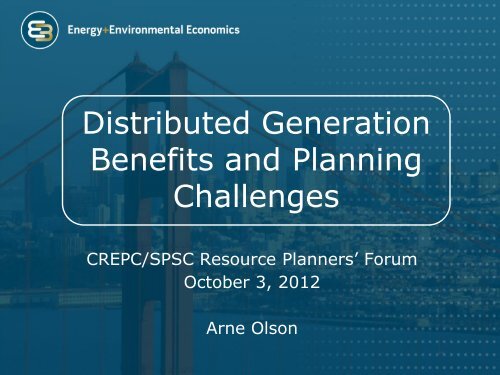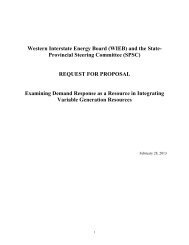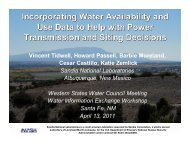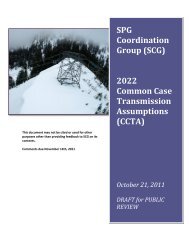What is DG?
What is DG?
What is DG?
- No tags were found...
You also want an ePaper? Increase the reach of your titles
YUMPU automatically turns print PDFs into web optimized ePapers that Google loves.
D<strong>is</strong>tributed GenerationBenefits and PlanningChallengesCREPC/SPSC Resource Planners’ ForumOctober 3, 2012Arne Olson
Agenda1. <strong>What</strong> <strong>is</strong> <strong>DG</strong>, and whatdoes it do for us?2. Is <strong>DG</strong> more costeffectivethan centralstation generation?(Hint: it depends onyour perspective.)3. Challenges inharvesting <strong>DG</strong> values:how current planningpractices account for<strong>DG</strong> (or not).4. Concluding Thoughts3
<strong>What</strong> <strong>is</strong> <strong>DG</strong>, and what doesit do for us?
<strong>What</strong> <strong>is</strong> <strong>DG</strong>?<strong>DG</strong> has beendefined in manydifferent waysdepending on thecontextd<strong>is</strong>tributedadjectivespread out or scattered about or dividedup [ant: concentrated]WordNet® 3.0, © 2006 by Princeton University.<strong>DG</strong> dimensions:• Size: 1 kW up to … 50 MW?• Location: customer side vs. utility side of meter• Interconnection point: d<strong>is</strong>tribution, sub-transm<strong>is</strong>sion, bulktransm<strong>is</strong>sion• Proximity to load: behind-the-meter, same d<strong>is</strong>tribution feeder, in aload pocket, remote from load• Technology type: PV, CHP, micro wind, fuel cells, microturbines,reciprocating engines5
Which of These are <strong>DG</strong>?Remote 20 MW sites identified byCalifornia’s RETIIllustrative Example of D<strong>is</strong>tributed Solar PV20 MW near substationsLarge commercial rooftopsResidential rooftops6
Why <strong>DG</strong>?<strong>DG</strong> has a number of potentialbenefits relative to centralstation generationRatepayer benefits:• High locational energy value inload pocket• Reduced losses (~7% average,up to 15% on peak)• Reduced need for newtransm<strong>is</strong>sion• Reduced need for newd<strong>is</strong>tributionNon-ratepayer benefits:• Reduced electricity bills forcustomer-side <strong>DG</strong>• Reduced land-use footprint insensitive ecological regions• Local jobs in economicallydepressedareas?• Increased consumer choice &autonomy?• More tangible/real thanremote RE?7
Spectrum of <strong>DG</strong> InterconnectionPointsSince <strong>DG</strong> can have many definitions, it <strong>is</strong> better tofocus on the benefits that generation can provideat different interconnection points4kV to21kV<strong>DG</strong> Interconnection PointsNeighborhood3 4D<strong>is</strong>tributionSubstation$C69kV to138kVCommunitySub-Trans.Substation$DNetworkTransm<strong>is</strong>sion230kV+ReferencePoint forCostingEx<strong>is</strong>ting HighVoltageSystem-$FNon-ex<strong>is</strong>tingTransm<strong>is</strong>sion230kV+Remote, newtransm<strong>is</strong>sion6Renewable energyzone$A$B2Gen Step-upSubstationMeterHome 1-$ERemote,5ex<strong>is</strong>tingtransm<strong>is</strong>sion8
Is <strong>DG</strong> More Cost-EffectiveThan Central StationGeneration?
Solar PV Costs Can VaryDramatically by LocationInstalled cost varies due to resource quality, size,installation type (shown as levelized $/MWh)Residentialrooftop (4 kW)$121Large, ground-mount(150 MW)Small, ground-mount(5-20 MW)$231$154$167$105Small, ground-mount(1-5 MW)Source: CPUC 33% RPSCalculator, April 201211
Example Values byInterconnection PointValues using CPUC “net cost” approach ($/MWh)Interconnection Point<strong>DG</strong> BenefitHome(5 kW)Neighborhood(1-5 MW)Community(5-20 MW)Remote,ex<strong>is</strong>ting Tx(150 MW)Remote,new Tx(150 MW)Levelized Cost $231 $167 $154 $121 $105Locational energy value -$39 -$39 -$39 -$34 -$34Reduced Losses -$3 -$3 -$1 - -Capacity Value -$35 -$35 -$35 -$38 -$38Reduced need ford<strong>is</strong>tributionReduced need fortransm<strong>is</strong>sion-$26 -$26 - - --$7 -$7 -$7 - +$20Net Ratepayer Cost $121 $57 $72 $49 $53Environmental/other benefits? ? ? ? ?Values based largely on CPUC RPS Calculator12
$/kWh<strong>DG</strong>PV Can Be Cost-Effective for NetMetered CustomersTypical California residential rates$0.40$0.35$0.30$0.25$0.20South CoastRooftop PVLCOESCEPG&ES<strong>DG</strong>&E$0.15$0.10SMUDLADWPSolar Rooftop PV LCOE$0.05$0.000 200 400 600 800 1000 1200Monthly Consumption (kWh)13
Challenges in Harvesting<strong>DG</strong> Values
Accounting for <strong>DG</strong> in ResourcePlanning<strong>DG</strong> <strong>is</strong> typically considered as aload modifier• Base load forecast developed viaeconometric estimation• Load modifiers to reflect demand-sidepolicies and programsRemaining net load served withleast-cost portfolio of supply-sideresources• Wires savings and other locationalvalues of demand-side resourcesfrequently not consideredUtility-side <strong>DG</strong> has not h<strong>is</strong>toricallybeen cost-competitive enough tomerit full consideration in IRP15
Accounting for <strong>DG</strong> in Transm<strong>is</strong>sionPlanningTransm<strong>is</strong>sion planning <strong>is</strong>done for multiple purposes,not all of which referencelocal value of <strong>DG</strong>• Interconnection: respond toservice requests (<strong>DG</strong> does nothelp)• Economic: relieve congestion(<strong>DG</strong> can help)• Reliability: serve load in localarea (<strong>DG</strong> can help)<strong>DG</strong> not considered astransm<strong>is</strong>sion option, but maybe reflected in load forecastLocal area studies aretypically based onmeeting NERC criteria(N-1, G-1)16
Concluding ThoughtsDramatic reduction in cost of PV has made <strong>DG</strong> a“live” option for the first time• We can now plausibly ask the question “Is it cost-effectiveto develop d<strong>is</strong>tributed resources close to load that do notrequire new transm<strong>is</strong>sion infrastructure?”• However, PV module cost reductions also affect cost ofcentral station solar resources<strong>DG</strong> can have significant additional value relative tocentral station resources in specific situations• Highest locational value occurs where resources are servingload downstream in a fast-growing areaThere are challenges in harvesting these valuesdue to utility planning and procurement practices19
Thank You!Energy and Environmental Economics, Inc. (E3)101 Montgomery Street, Suite 1600San Franc<strong>is</strong>co, CA 94104Tel 415-391-5100Web http://www.ethree.comArne Olson (arne@ethree.com)
















